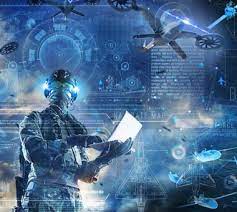The New Age of Warfare: How Technology is Redefining the Battlefield
The battlefield is no longer just about soldiers and weapons—technology now plays a decisive role in modern conflicts. From AI-powered drones to cyber warfare and satellite surveillance, military strategies are evolving at a rapid pace.
Bashka
2/5/20253 min read


The battlefield is no longer just about soldiers and weapons—technology now plays a decisive role in modern conflicts. From AI-powered drones to cyber warfare and satellite surveillance, military strategies are evolving at a rapid pace. Nations and non-state actors are leveraging cutting-edge tools to gain a strategic advantage, raising both ethical concerns and global security challenges.
Real-World Scenarios
🔹 Drones & AI in Combat
AI-powered drones are revolutionizing warfare. In the Ukraine-Russia war, both sides are deploying autonomous drones for surveillance, reconnaissance, and targeted strikes. These unmanned aerial vehicles (UAVs) operate with high precision, reducing the need for direct human engagement on the front lines.
🔹 Cyber Warfare & Digital Attacks
Modern conflicts are increasingly fought in cyberspace. During international tensions, state-backed hackers target financial institutions, power grids, and military databases. In the ongoing Israel-Gaza conflict, cyberattacks have been launched against both government agencies and media outlets to manipulate narratives and disrupt operations.
🔹 Satellite Surveillance & Intelligence
High-resolution satellite imagery is being used to track troop movements, identify strategic locations, and provide real-time intelligence. In the Red Sea tensions, satellite surveillance has played a crucial role in monitoring maritime routes and detecting potential threats to global trade and security.
🔹 Autonomous Defense Systems
AI-driven missile defense systems, such as Israel’s Iron Dome, are designed to detect and intercept incoming threats with extreme precision. These automated defense technologies are reducing casualties and shifting the balance of military power.
The Future of War: Where Are We Headed?
With rapid technological advancements, warfare is becoming more automated, precise, and intelligence-driven. But this also raises concerns: How do we regulate AI in combat? Are cyberattacks the future of global conflicts?
How Technology is Reshaping Modern Warfare
By Somlens Editorial Team
The nature of warfare has drastically changed over the years, evolving from conventional battlefield engagements to high-tech, intelligence-driven operations. Today, wars are not just fought with guns and tanks but with artificial intelligence (AI), cyber warfare, drones, and satellite surveillance. From the battlefields of Ukraine to tensions in the Red Sea, technology has become the deciding factor in modern conflicts.
1. The Rise of AI-Powered Drones
Drones have revolutionized modern warfare, offering precision strikes, real-time reconnaissance, and unmanned combat capabilities. In the Ukraine-Russia war, AI-powered drones are being used extensively for surveillance and targeted strikes, reducing human risk while increasing efficiency. These drones can operate autonomously, recognizing enemy targets and striking them with precision.
For example, Ukraine has used Bayraktar TB2 drones effectively against Russian forces, while Russia has deployed Shahed drones to target infrastructure. AI is enabling these drones to identify, track, and attack enemies without human intervention, raising serious concerns about the future of warfare.
2. Cyber Warfare: A Silent Battleground
The battlefield is no longer just on land, sea, and air—cyberspace is now a critical warfront. Governments and militaries use cyberattacks to disrupt enemy communications, disable critical infrastructure, and spread misinformation.
Recent real-world examples include:
Ukraine Conflict: Russia has launched massive cyberattacks against Ukrainian government systems, banking institutions, and energy grids. In response, Ukraine and its allies have fought back with defensive cyber operations.
Israel-Gaza War: Hackers from both sides have targeted government websites, news outlets, and social media platforms to influence public perception and disrupt enemy operations.
U.S.-China Cyber Tensions: Both nations have accused each other of cyber espionage, targeting defense agencies, tech firms, and political institutions.
With AI-powered cyber warfare tools, hackers can now automate cyberattacks, making them more frequent and difficult to prevent.
3. Satellite Surveillance & Intelligence Gathering
Satellites have become essential tools for real-time intelligence gathering, missile tracking, and global surveillance. High-resolution satellite images can monitor troop movements, detect hidden military bases, and provide strategic insights.
A recent example is the Red Sea tensions, where satellite surveillance helped monitor Houthi rebel activities and maritime threats. Countries like the United States, China, and Russia heavily rely on satellites to predict enemy strategies and enhance national security.
With the advancement of AI, satellite surveillance systems can now analyze vast amounts of data faster, identifying potential threats with unprecedented accuracy.
4. Automated Defense Systems: The Future of Military Security
Defense systems are no longer just manual operations—AI-driven missile defense systems and automated response units are becoming standard in military operations.
Key Examples:
Iron Dome (Israel): This AI-driven missile defense system can detect, track, and intercept incoming threats with extreme precision, protecting cities from aerial attacks.
S-500 (Russia): A next-generation air defense system that can counter both ballistic missiles and stealth aircraft.
AI-Assisted Combat Robots: Some nations are developing autonomous ground robots capable of identifying and neutralizing threats without human intervention.
5. Ethical Concerns & The Future of War
As technology continues to shape modern warfare, ethical and legal concerns are growing.
🔹 Should AI-powered weapons have the authority to decide life and death without human oversight?
🔹 Are cyberattacks considered acts of war?
🔹 How can we prevent global security risks associated with AI-driven conflicts?
The future of warfare is becoming increasingly digital, autonomous, and intelligence-driven. While technology improves military precision and efficiency, it also raises questions about accountability, security, and global stability.
Final Thoughts
Technology is redefining war, making it smarter, faster, and deadlier. AI, drones, cyber warfare, and surveillance tools are transforming conflicts worldwide. As these innovations continue to evolve, nations must consider the ethical and geopolitical implications of high-tech warfare.
